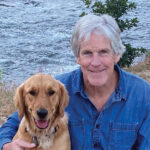From the Editor: March/April 2018
A note from our editor in chief, Stephen Kiesling.
Many readers will remember the 1987 launch of James Gleick’s great book Chaos: Making of a New Science, and the idea that the flap of a butterfly’s wing can be the catalyst for a hurricane. At a lecture Gleick gave at the launch, what struck me was a video he showed on the mathematics of chaos theory. The video started with simple lines on the screen—the graph of an equation—that got more and more complex until what once looked like math now looked and moved like a living cell, as if chaos were an organizing principle of life.
Since then, we’ve learned how much chaos is actually inside us: those trillions of bugs that go about their own business and keep us alive. A human turns out to be a bus full of odd critters, and now we’re learning that cancer, too, is always on board. We “tend toward cancer, not away from it,” explains oncologist Dawn Lemanne MD. So the odd flap of a butterfly in the backseat of the bus can let loose a hurricane inside us.
What Maria Shriver calls “The Power of the Pause” (24) is to take a stand against chaos, moment to moment. Her extraordinary life has allowed her to reflect on critical places to pause: how hard it is, and how important. This reminds me of an excruciating pause my family had to take last year with my son: a very long week, from the time the tumors were found by X-ray to receiving the final pathology report that identified exactly which one of some 200 possible cancers it was. The tumors were large and fast growing, involving an emergency airlift to keep him alive, and yet any actual treatment for the cancer before the final report would likely have contributed to chaos. We had to pause—and now he’s doing fine.
So I read Maria Shriver’s list of places to pause and Dr. Lemanne’s advice on “How Not to Feed Your Cancer” (42) and asked myself, What am I feeding right now? Is it healthy? Or is it more chaos? The pause allows me to choose.
My friend Allan Hamilton MD is working on a big book about the brain, of which I’ve been reading a first draft. Dr. Hamilton is a brain surgeon and medical advisor for what has become more than 300 episodes of Grey’s Anatomy, so he’s the reality check for those great TV medical stories, as well as being a great storyteller himself. One of his stories that I had to include here is “The Source of Flow & the Battle of the Bottleneck.” Flow is profound joy: the opposite of chaos. Understanding how the thalamus creates flow can help answer big questions, like how to best respond to information overload—how to feed our joy instead of consuming chaos.
One of my most joyful moments working on this issue happened on the balcony at the historic Columbia Café in Tampa, Florida. On a day that felt like spring, I was eating a delicious Cuban sandwich when I overheard waitress RozAnne Petito gently chastising the guests at the table next to mine. I asked RozAnne why she did it, and she told me about feeding the birds, a fine story for our new Community Journal (38). She then asked if I would like to hear a poem she had written for—and given to—Bob Dylan, born Robert Zimmerman (18). It felt glorious. The restaurant was busy, yet there was time enough for her to share a moving story and a well-loved poem. We celebrate both. Happy Spring!
Stephen Kiesling


